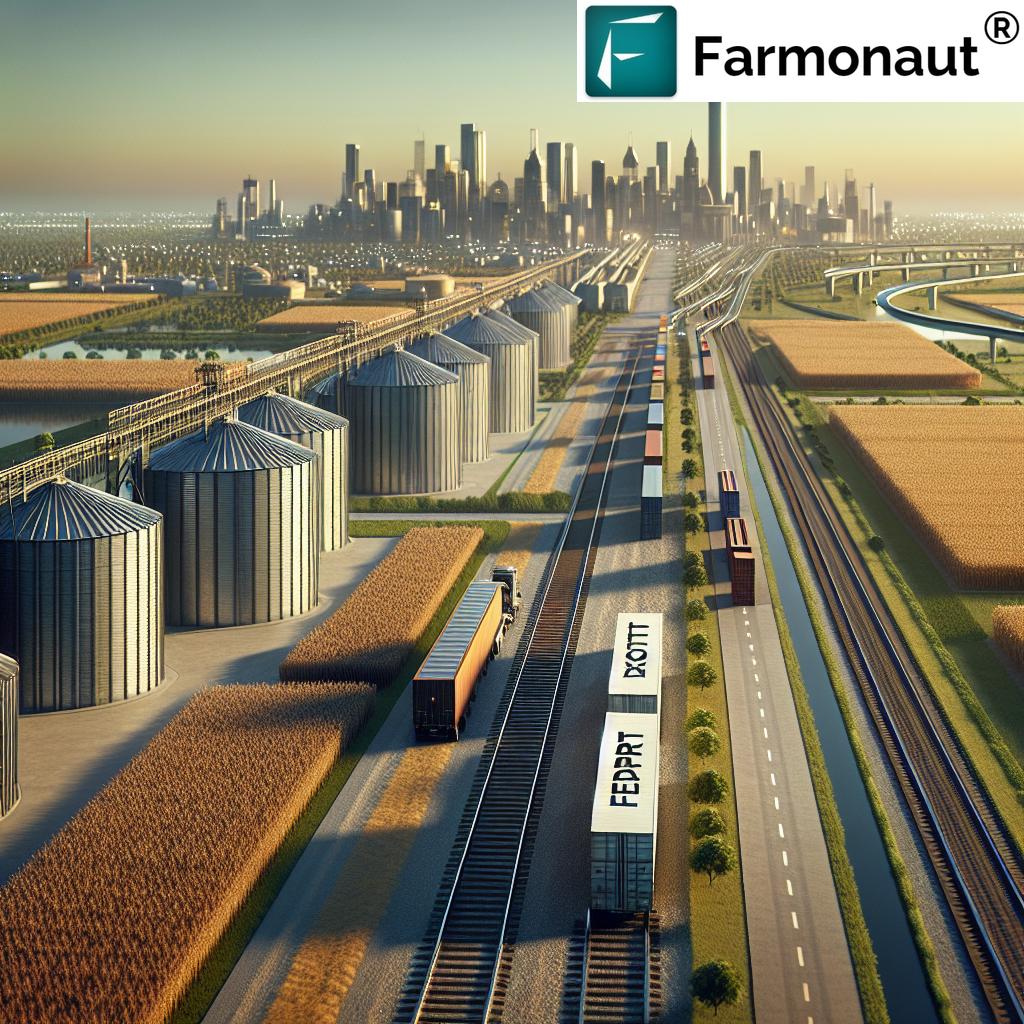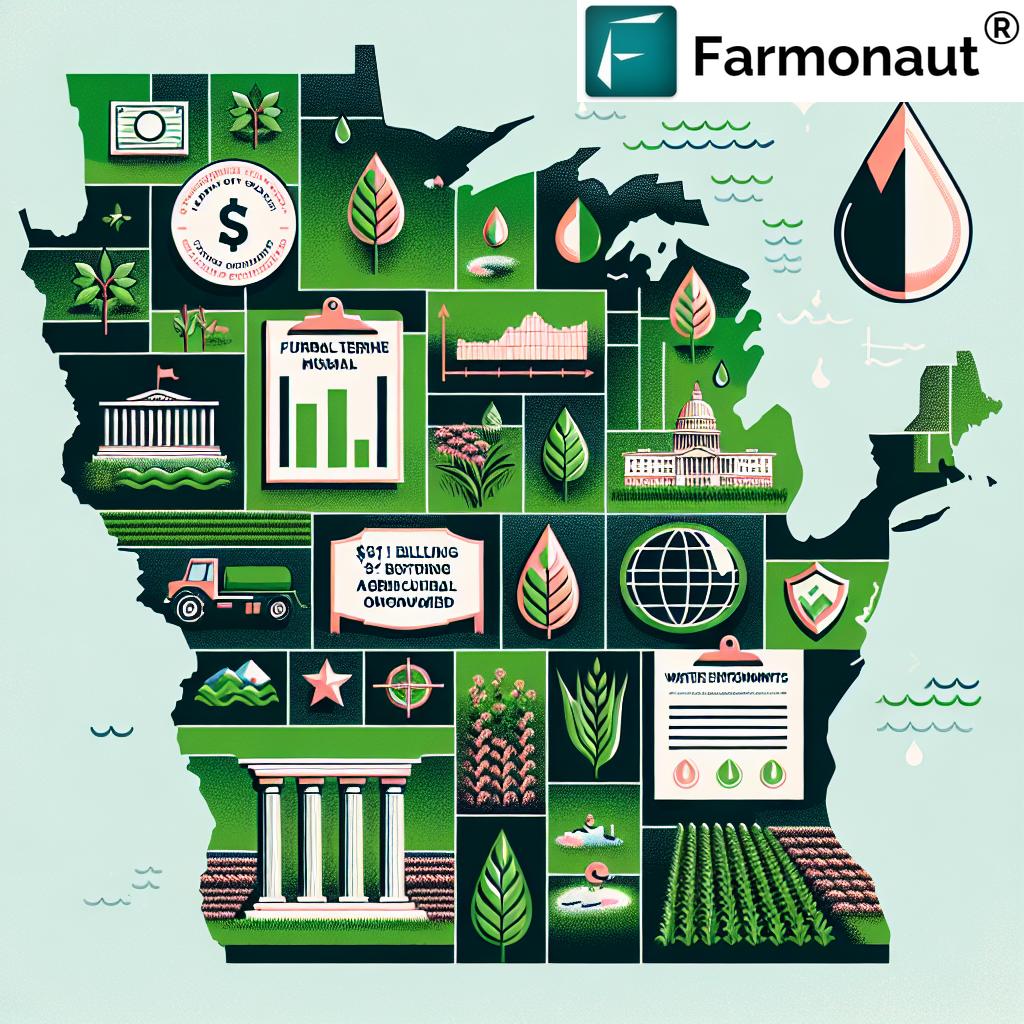Table of Contents
- Introduction: China Trade Tariffs Slashed
- Context: Geneva Tariff Agreement Explained
- Summary of the US China Tariff Deal
- 5 Powerful Impacts of Lowered Trade Tariffs on Global Markets
- Comparative Impact Table: Before & After US China Tariff Deal
- Farmonaut’s Technologies in Navigating Trade Policy & Agriculture
- Future of Global Trade Agreements: What Lies Ahead?
- Frequently Asked Questions (FAQ)
- Farmonaut Subscription & Next Steps
China Trade Tariffs Slashed: 5 Powerful Impacts on Global Markets
In a historic move announced in Geneva, the United States and China have agreed to slash previously imposed trade tariffs, creating a dramatic shift in the global trade landscape. This agreement, resonating far beyond Beijing or Washington, has immediate and profound effects on international markets, economies, and even everyday consumers from the United States to central counties across Asia and Europe.
As representatives of Farmonaut, we understand how critical such changes in china trade tariffs are—not just for major financial markets, but for grain farmers, agribusinesses, and technology providers like us, who are deeply invested in the stability and progress of global trade policies.
Context: Geneva Tariff Agreement Explained
The recent trade agreement between countries—specifically the United States and China, finalized in Geneva—set a precedent for global economic cooperation. For months, both Beijing and Washington raised tariffs to unprecedented levels, triggering anxiety among investors and businesses worldwide. Now, by agreeing to lower US tariffs on Chinese goods from 145% to 30%, and Chinese tariffs on American exports from 125% to 10%, the two largest economies have taken a major step to de-escalate tensions.
However, as we analyze this deal, it’s important to realize that while lowering tariff rates alleviates some pains, the agreement remains tentative—lasting only 90 days to allow for further negotiation. This makes the impact of tariffs on global markets both a current event and an evolving storyline.
Summary of the US China Tariff Deal
- U.S. agrees to drop its punitive tariffs on Chinese goods from 145% to 30%.
- China lowers tariffs on U.S. goods from 125% to 10%.
- The agreement lasts 90 days, pending further negotiations.
- The announcement led to strong rallies on global financial markets.
- Significant uncertainty remains for businesses and investors regarding future trade policy and economic growth.
5 Powerful Impacts of Lowered Trade Tariffs on Global Markets
1. Boost to Global Financial Markets
The financial markets reaction to trade news was immediate and resounding. Upon the Geneva announcement, major stock indices experienced sharp rallies—U.S. futures climbed more than 2%, Hong Kong’s Hang Seng index rose close to 3%, and European benchmarks followed with substantial gains.
This reinforces the pivotal role that trade agreements play in investor sentiment. For months, global uncertainty hampered growth and liquidity, with businesses in leading economies adopting a cautious stance. Now, with tariffs lower (even if temporarily), financial institutions have more confidence, and we’re likely to see increased trading volumes, cross-border capital flows, and renewed risk appetite among central investors.
- Stock markets see rallies upon announcement of the truce
- Investors become more optimistic, reducing “embargo-era” market stress
- Potential for stronger corporate earnings due to improved trade flows
Farmonaut works with financial institutions, especially for satellite-based verification that streamlines crop insurance and crop loans:
Learn about Farmonaut’s crop loan and insurance verification services →
2. Shift in Global Supply Chains and Trade Flows
By lowering tariff rates, both nations unlocked trade flows that had been severely restricted. This impact goes beyond just U.S. and Chinese businesses—it reshapes the movement of goods, components, and raw materials for counties and economies globally. American grain exports, electronics from central Chinese provinces, and automotive parts from European factories all stand to benefit from lower trade friction.
However, the future of global trade agreements is far from secure. Many industries may seek to diversify supply chains, learning from past shocks. Export controls and trade barriers, such as those temporarily suspended in this deal, could still return if the 90-day truce falters.
- More predictable flows for agricultural, electronics, and automotive sectors
- Reduced cost and lead times for global manufacturers and distributors
- Pressure on companies to enhance blockchain-based traceability, ensuring supply chain resilience (see Farmonaut’s solution).
See how Farmonaut uses blockchain for product traceability in agriculture →
3. Economic Effects in Central Grain-Producing Regions
Central grain-producing regions, often deeply affected by shifts in export controls and trade barriers, experience substantial ripples due to the US China tariff deal. Counties in Nebraska and similar agricultural areas were among the first to feel changes, with local grain silos once brimming due to unsold stock now finding new export opportunities.
For businesses and cooperatives operating at the intersection of technology, policy, and agriculture, Farmonaut’s large-scale farm management solutions become critical. Advanced monitoring, AI-driven advisory, and carbon footprint tools ensure farmers can respond to market changes with agility and sustainability.
The impact of tariffs on global markets for agricultural commodities is broad:
- Grain, soybean, and corn prices become more competitive on the export market
- Farm revenues rise as international buyers re-engage
- Lower input costs, from fertilizers to machinery, as supply chain frictions decrease
- Governments must revisit subsidy and support policies in light of new trade realities
Explore Farmonaut’s carbon footprint tracking for sustainable agribusiness →
4. Policy Shifts, Trade Agreements, and Future Economic Growth
The Geneva-based trade agreement between countries signals not just a truce but an evolving policy landscape. As nations measure the effects of tariffs on global markets, governments are compelled to seek new, resilient trade agreements—balancing national interests with the imperative for economic growth.
The future of global trade agreements will likely be characterized by ongoing negotiations, digital trade policy integration, and the adoption of advanced technology for monitoring and compliance. China wants the US to abandon “unilateral tariff hikes” while safeguarding bilateral economic development. Both sides have temporarily suspended export control escalations, particularly for strategic goods such as rare earth elements essential to central electronics, automotive, and defense industries.
- Accelerated digitalization of cross-border trade oversight
- Increased use of AI-driven resource management to avoid supply shocks
- Intensified government consultations, involving both ministry and industry stakeholders
For policymakers and agribusiness leaders, leveraging API-based solutions is crucial. Farmonaut’s API provides direct access to satellite and weather data for custom trade analytics and resource planning.
Access Farmonaut’s API: Unmatched agility for real-time agri-intelligence →
See API Developer Docs
5. Consumer Savings and Price Adjustments
While much attention is paid to macroeconomic and supply-side effects, the effects of tariffs on consumers are equally profound. Previously, high tariffs resulted in price hikes for electronics, textiles, and even food products. As tariff rates fall, central to this truce, we expect to see relief for millions of consumers—from city shops in Beijing to rural households in the United States, and across international markets.
- Decreased consumer prices for imported goods
- Broader product variety as global imports resume
- Pressure on domestic producers to innovate and remain cost-competitive
As we move towards global price stabilization, technologies that boost resource efficiency and transparency—like Farmonaut’s fleet management and digital traceability fleet management system—offer businesses tools to pass cost savings on to end-users.
Comparative Impact Table: Before & After US China Tariff Deal
| Market Segment | Estimated Tariff Rate Before Slashing (%) | Estimated Tariff Rate After Slashing (%) | Key Impact on Global Markets | Estimated Global Trade Change (%) |
|---|---|---|---|---|
| Agriculture (grain, soy, corn) | 125% (China); 145% (US) | 10% (China); 30% (US) | Price Drop, Export Recovery, Stock Relief in storage silos | +15% |
| Electronics & Consumer Goods | 120% (China); 135% (US) | 10% (China); 30% (US) | Supply Chain Shift, Broader Product Variety | +12% |
| Automotive | 110% (China); 130% (US) | 10% (China); 30% (US) | Global Price Competition, Component Flow Recovery | +10% |
| Rare Earth Exports | Special Export Controls | Suspended Controls | Defense/Electronics Supply Chain Stability | +5% |
| Textiles & Apparel | 115% (China); 110% (US) | 10% (China); 30% (US) | Consumer Price Drop, Global Sourcing Expansion | +8% |
* All values are approximate estimates based on announced tariff changes and historical global trade data.
Farmonaut’s Technologies Navigating Trade Policy & Agriculture
As global trade policies impact everyone—from government representatives shaping economic policy to local businesses in central grain counties—technology partners like Farmonaut offer advanced analytics for effective decision-making. Utilizing satellite imagery, AI advisory, and blockchain, Farmonaut provides scalable solutions for farm management, environmental compliance, and market adaptation.
Key Technologies in a Volatile Trade Environment
- Satellite-Based Crop Health Monitoring: Enables farmers to react swiftly to new export opportunities, optimizing irrigation, fertilizer, and resource usage.
- AI-Driven Agri-Advisory: Real-time weather and crop management insights support both individual farmers and large agribusinesses navigating volatile policies.
- Blockchain-Based Traceability: Transparent supply chains protect businesses from sudden export controls or shifts in tariff regulations.
- Fleet and Resource Management: Streamlines transport and logistics so that grain and goods move efficiently under new trade conditions. Discover fleet management
- Carbon Footprinting: Supports compliance with increasingly strict global trade and environmental standards. Learn more
- Crop Loan and Insurance Verification: Helps financial institutions adapt to changing economic conditions by minimizing risk with satellite-based verification.
Future of Global Trade Agreements: Stability or Renewed Volatility?
While this Geneva-based china trade tariffs reduction is a powerful step towards market stability, the short-term nature of the agreement (90 days) means uncertainty lingers. The world is watching Beijing and Washington, eager to see if underlying issues—technology, intellectual property, export controls—will be resolved, or if new trade battles will emerge.
The lesson for governments, businesses, and especially central agricultural regions is clear: agility, transparency, and data-driven decision-making are essential in an unpredictable global economy. Farmonaut’s digital platform is uniquely positioned to support all stakeholders—farmers, agribusinesses, policy makers—during both disruptive shocks and long-term recovery.
Frequently Asked Questions (FAQ) on China Trade Tariffs and Their Global Impact
1. What are China trade tariffs?
China trade tariffs are taxes imposed on goods exported to or imported from China. These rates fluctuate based on international agreements and government policy, affecting global supply and demand.
2. How does the US China tariff deal affect farmers and agribusinesses?
By lowering tariffs, the deal restores export opportunities, increases farm revenues, and reduces the cost of importing essential inputs for agricultural production. This is particularly beneficial for grain farmers and counties dependent on agricultural trade.
3. What sectors benefit most from the trade agreement between countries?
Key sectors include agriculture, electronics, automotive, and textiles. All experience a drop in tariffs, greater market access, and a more stable business environment.
4. What’s the risk if negotiations stall after 90 days?
If the truce collapses, tariffs could rise again, disrupting global supply chains and hurting both economies and consumers. This would return uncertainty to markets and impact both exports and imports dramatically.
5. How do consumers benefit from lower tariffs?
Consumers enjoy lower prices on imported goods, more product choices, and less inflationary pressure. This directly improves purchasing power in both developed and developing nations.
6. How can technology help us navigate trade policy volatility?
Platforms like Farmonaut provide real-time insights, supply chain transparency, and environmental compliance tools, empowering all stakeholders to adapt to rapid policy changes with minimal disruption.
Farmonaut Subscription & Next Steps
Ready to equip your agricultural or business operations with industry-leading satellite, AI, and blockchain-powered analytics? Explore our flexible subscription plans below:
Conclusion: Embracing a New Era in Global Trade and Agriculture
The slashing of China trade tariffs marks a pivotal moment with far-reaching impacts across continents, sectors, and communities—from the grain silos of Central Nebraska to the tech-driven farms of Asia. Although uncertainty remains, improved trade policy coordination and technology adoption offer hope for long-term resilience and prosperity. At Farmonaut, we’re committed to empowering farmers, businesses, and industry leaders through innovation, transparency, and smart adaptation—no matter where trade winds may shift.


















